Purpose of work: Explore and show unusual ways of multiplication Tasks: Find unusual ways of multiplication. Learn to use them. Choose for yourself the most interesting or easier ones than those offered at school, and use them when counting. Teach classmates to use a new way of multiplication

In the following articles, you will learn how to create different types of squares and increase your knowledge in the section. The biblical narrative is interrupted by numbers and numbers. Although it is appropriate not to overcount, knowledge of their symbolic meaning is valuable to clarify the text in many cases.
What place do numbers have in the Bible?
Numbers play an important role in the Bible. Their use must be placed in the larger context of the ancient East, which loved the symbolism of numbers. In Mesopotamia, where mathematics was relatively developed, the authors vocabulary Biblical theology recalls that some sacred numbers were attributed to the gods. According to Pythagoras' predictions, 1 and 2 were male, 3 and 4 female, 7 virgin, etc.
Methods: search method using scientific and educational literature, as well as searching for the necessary information on the Internet; a practical method of performing calculations using non-standard counting algorithms; analysis of the data obtained during the study. The relevance of this topic lies in the fact that the use of non-standard techniques in the formation of computational skills increases students’ interest in mathematics and promotes the development of mathematical abilities

Influenced by the civilizations in which it was composed, the Bible itself ascribes certain numbers with symbolic and customary uses. With all this, it does not give a sacred character. Esoteric literatures use numbers to make magical readings, warns Father François Brossier, exegete and professor emeritus at the Catholic Institute of Paris. In the Bible they first serve to give meaning. It is absolutely necessary to ask what the authors' intentions were when they used them.
Do we know the symbolic meaning of all the figures?
First of all, this is not a matter of hasty extrapolations. Nevertheless, symbolic meaning some figures in the Bible were also gradually imposed. Thus, Jesus chose twelve apostles because Israel originally consisted of twelve tribes, a symbolic figure, indicating by this figure the new people of God.
In math lessons we learned an unusual way of multiplying by columns. We liked it and decided to learn other ways to multiply natural numbers. We asked our classmates if they knew other ways to count? Everyone talked only about those methods that are studied at school. It turned out that all our friends knew nothing about other methods. In the history of mathematics, about 30 methods of multiplication are known, differing in the notation scheme or the course of the calculation itself. The columnar multiplication method that we study at school is one of the methods. But is this the most effective way? Let's take a look! Introduction

This symbolic meaning is reinforced by the use of multiples. When Jesus tells Peter to forgive “not up to seven times, but 77 times,” he is pointing to the perfection of gospel love, which has no limits. Likewise, the number of disciples awaiting Pentecost is 120, or 10 times 12, symbolic of this new people of God that are beginning to be born.
The New Testament writers naturally drew from Old Testament symbolism well known to their readers to bring out the mystery of Christ. How to mean that Jesus entrusts them with the task of bringing the Gospel to all the nations of the world. In the Gospel of St. Mark there are two testimonies about the multiplication of the loaves. At the end of the first there were twelve full baskets left, the number of twelve tribes. This multiplication is for Israel, it is the fulfillment of the promises God made to the people in the wilderness. He sends the Messiah to satisfy his people and gather around their Lord.

This is one of the most commonly used methods, which Russian merchants have successfully used for many centuries. The principle of this method: multiplication on fingers single digit numbers from 6 to 9. The fingers here served as an auxiliary computing device. To do this, on one hand they extended as many fingers as the first factor exceeds the number 5, and on the second they did the same for the second factor. The remaining fingers were bent. Then the number (total) of extended fingers was taken and multiplied by 10, then the numbers were multiplied, showing how many fingers were bent, and the results were added up. For example, let's multiply 7 by 8. In the example considered, 2 and 3 fingers will be bent. If you add up the number of bent fingers (2+3=5) and multiply the number of not bent ones (23=6), you will get the numbers of tens and ones of the desired product 56, respectively. This way you can calculate the product of any single-digit numbers greater than 5.

In the second count, seven baskets remain, the number of which evokes completeness according to God: Jesus moves in crowds that follow him, four thousand people, that is, from the four points of the horizon, the nations gathered together, far beyond the borders of the people of Israel. Thus these two multiplications of the loaves of which St. Mark tells us were intended to show that he was going to gather the tribes of Israel, and also for all nations.
What value does Judaism place on numbers?
On the other hand, on the other hand, the key to interpretation eludes us today. Intriguingly, there are 153 fish from a wonderful fishing trip that has given rise to many hypotheses, some extravagant for the modern spirit. This means that we can assign a numerical value to each word by adding up the sum of its letters. There are various methods of construction and interpretation, partly provided by texts, partly by oral tradition, which are part of what is called gematria.
Multiplication for the number 9 is very easy to reproduce “on your fingers.” Spread your fingers on both hands and turn your hands with your palms facing away from you. Mentally assign numbers from 1 to 10 to your fingers, starting with the little finger of your left hand and ending with the little finger of your right hand. Let's say we want to multiply 9 by 6. We bend the finger with the number, equal to the number, by which we will multiply nine. In our example, we need to bend the finger with number 6. The number of fingers to the left of the bent finger shows us the number of tens in the answer, the number of fingers to the right shows the number of ones. On the left we have 5 fingers not bent, on the right - 4 fingers. Thus, 9·6=54.

This process is probably explained by a certain number of New Testament figures. The most famous biblical game of gematria, according to the biblical Jerome Martineau, is what was found in the Apocalypse regarding the number 666, which is supposed to represent the Beast.
It was also proposed to see 3 times the 14 generations that make up the genealogy of Jesus, in the Gospel of Matthew, which was addressed especially to the Judeo-Christian communities, Gematria named David. Because it was hoped that the Messiah would become a descendant of David, the evangelist thus called Jesus the “triple David,” the true descendant of the prophet king. But it is also a multiple of the number 7, the figure of God.

“Small Castle” multiplication method The advantage of the “Small Castle” multiplication method is that the most significant digits are determined from the very beginning, and this is important if you need to quickly estimate a value. The digits of the upper number, starting from the most significant digit, are multiplied in turn by the lower number and written in a column with the required number of zeros added. The results are then added up.

Everyone intuitively suspects that education is a key factor in a well-functioning society. What does the expert think about this phenomenon? Education has no economic value for a person. Well-educated people live longer, are healthier, smoke less, educated countries have more low level crime and corruption. This means that given the same amount of resources, people can produce more and therefore have higher wages.
The impact of the quality of an education system on the prosperity of a society is now much more important than other factors such as natural wealth, access to climate or ocean. Research shows that quality of education is of paramount importance in early age, starting from preschool age. The difference between the lifetime future earnings of a student who had a bad teacher in elementary school, and a student who is lucky enough to have a good teacher is approximately 000 to 000 euros per year of study, notes Jan Liebich.
“Jealousy” or “lattice multiplication” First, a rectangle is drawn, divided into squares, and the dimensions of the sides of the rectangle correspond to the number of decimal places in the multiplicand and the multiplier. Then the square cells are divided diagonally, and “... the result is a picture similar to lattice shutters, - writes Pacioli. “Such shutters were hung on the windows of Venetian houses...”

Thus, a student who has the first five years of high school will earn a lifetime of between 000 and 000 euros, says Jan Liebich. The Czech economist arrived at these figures by altering US data and findings about the Czech Republic's environment. He used the methodology of Professor Hanushek from Stanford University. "If we compare this, good teacher in elementary or high school can have a similar impact on a student's future career and college earnings,” adds Jan Liebich.
There are certain key factors that have a positive impact on education. Jan Liebich considers it necessary. By reducing the number of students per class from 30 to 22, it has an effect. Further contraction of the pupils does not have a significant effect.
Lattice multiplication = +1 +2

Peasant method This is the method of Great Russian peasants. Its essence lies in the fact that the multiplication of any numbers comes down to a series of successive divisions of one number in half, while simultaneously doubling another number……….32 74……………….8 296……….4 592……… ………1 3732=1184

Modern technologies have such a significant impact on improving learning effectiveness because they were originally intended. Recent research shows that the biggest impact on education is the quality of the teacher. As a problem, Jan Liebich also believes that the salaries of a high-quality and a poor teacher are almost not similar to each other, and this is very sad. The reason for the reform of the school system is mainly because a quality teacher must be properly assessed as he has a significant impact on the economy of the state.
Peasant way (odd numbers) 47 x =1645


Step 1. first number 15: Draw the first number – with one line. Draw the second number with five lines. Step 2. second number 23: Draw the first number with two lines. Draw the second number with three lines. Step 3. Count the number of points in groups. Step 4. Result – 345. Multiply two double digit numbers: 15*23

Fair salaries for highly qualified teachers would attract excellent high school graduates who want to study in the future and will have a strong desire to study in education departments and will not choose this college as a last possible solution.
We can also give the example of reform in Poland, where schools were given greater autonomy, but also responsibility. “Knowledge is the power of the key” and “There is so much mathematics in science”, these two statements perfectly and without a shadow of a doubt illustrate how, before true science, such nonsense as theology, numerology, astrology or psychology were incompetently pretended for centuries.
Indian way of multiplying (cross) 24 and X 3 2 1)4x2=8 - the last digit of the result; 2)2x2=4; 4x3=12; 4+12=16 ; 6 is the penultimate digit of the result, remember the unit; 3) 2x3 = 6 and also a number held in mind, we have 7 - this is the first digit of the result. We get all the numbers of the product: 7,6,8. Answer: 768.
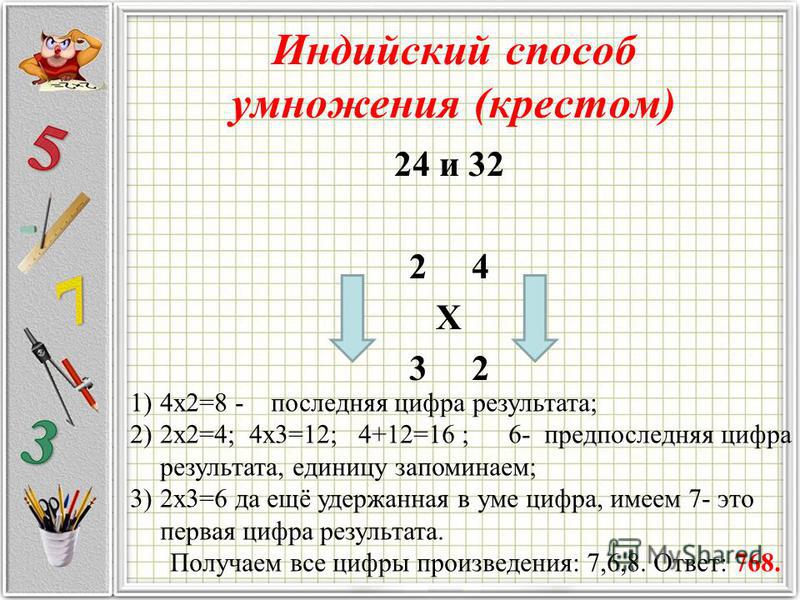
There's no math or even grams, so they're not just learning. But science, such as computer science or astronomy, contains almost 100 percent mathematics, and that is why they are real science and their graduates are real scientists. True mental elite, mocking muttering.
Today, however, we are not concerned with babbling, but we will learn a piece of pure Aryan mathematics, that is, juggling large numbers. Jugglers in which, obviously, there is no place for “miracles”, “incidents” or “phenomena” originating from numerology or astrology. We will learn the true miracle of true Aryan mathematics.
Indian way of multiplication = = = = 3822 The basis of this method is the idea that the same digit represents units, tens, hundreds or thousands, depending on where the digit occupies. The occupied space, in the absence of any digits, is determined by the zeros assigned to the numbers. We start the multiplication from the highest digit, and write down the incomplete products just above the multiplicand, bit by bit. In this case, the most significant digit of the complete product is immediately visible and, in addition, missing any digits is eliminated. The multiplication sign was not yet known, so a small distance was left between the factors

In Aryan mathematics there are several phenomenal solutions, such as multiplying any number by eleven. For this purpose, the fifth rule of Aryan mathematics is used: if samukaya is equal, then it is equal to zero. This is a very powerful rule and allows the result to be instantly calculated in memory - even by those who were previously disabled in science. Experience this magic in ordinary life taken example.
For example, we should list this extremely difficult task, which overwhelms even the student of “normal” mathematics if she is deprived of a compass, a cell, a pen or a calculator. If one Jew cries at the Western Wall 24 times a minute, how many Jews will eleven Orthodox Christians do at that time?
Reference number Multiply 18*19 20 (reference number) * 2 1 (18-1)*20 = Answer: 342 Short notation: 18*19 = 20*17+2 = 342
![]()
New way multiplication X = , 5+2, 5+3, 0+2, 0+3, 5
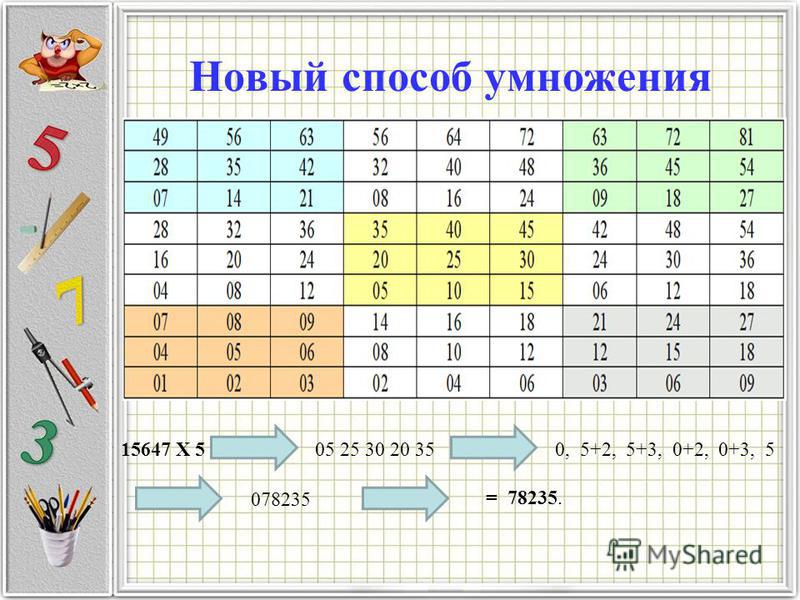

And now the Aryan mathematician enters. Well, to calculate the result in memory, we simply add two digits of 24 or 2 4 and we're out. This is the result that we put between the numbers 24, and here we have 264 - and this is " final decision"of our "Jewish question".
The sum of 6 6 is 12, and this number is introduced into the measure 66, but little attention is paid, because we get the result of adding two digits of twelve added to the first number, and the "final solution of the Jewish question" looks like a total of 726 people these Jews are wiping.
There is no magic here - this is the powerful weapon of this arithmetic mathematician and even when you speed up the Jews to 99 nicks per minute, which is already serious, because this is the striking speed of the hammer and mikes 99 times per minute in the wailing wall, it will not save us the end result . Bah, even if they nod so quickly that they will no longer be clearly visible, because they will start to blur, and the eyes of Aryan mathematicians will always count them in a very simple way.


Conclusion: Having learned to count in all the presented ways, we came to the conclusion that the most simple ways these are the ones we study at school, or maybe we’re just used to them From all those considered unusual ways The method of graphical multiplication seemed more interesting. We showed it to our classmates and they really liked it too. The simplest method seemed to be “doubling and splitting”, which was used by Russian peasants. After working with literature and materials on the Internet, we realized that we had considered a very small number of multiplication methods, which means that a lot of interesting things await us ahead

The important thing is that they are no longer unpredictable. If so, it means that you have a person with Aryan mathematical innate talent. Their faces will be priceless, guaranteed to you - this is bacology - the most thorough science. And don't worry about the fact that there are some Jews living there by the wall, because for Jews it is pure pleasure, and those who didn't go there didn't even bother to eat there.
Where did the wonderfully simple methods of the above calculations come from? Now this is probably the question you are asking. So make some history. The Aryan Vedic Slavs are the oldest trace of human writing. They are at least 140,000 years old and contain ancient Aryan knowledge. Vedas simply means Knowledge. The Vedas contain not only chronicles of past events, predictions of the future and guidance of the rules of broadly understood life, which are the unsurpassed model of all religions, but also contain such specific knowledge as, for example, mathematics.
Conclusion By describing ancient methods of calculation and modern methods of quick calculation, we tried to show that, both in the past and in the future, one cannot do without mathematics, a science created by the human mind. The study of ancient methods of multiplication showed that this arithmetic operation was difficult and complicated due to the variety of methods and their cumbersome implementation. The modern method of multiplication is simple and accessible to everyone. But we think that our method of multiplying by column is not perfect and we can come up with even faster and more reliable methods. It is possible that many people will not be able to quickly, right away, perform these or other calculations the first time. It doesn’t matter. Constant computational training is needed. It will help you acquire useful mental arithmetic skills!
Materials used: html Encyclopedia for children. "Mathematics". – M.: Avanta +, – 688 p. Encyclopedia “I explore the world. Mathematics". – M.: Astrel Ermak, Perelman Ya.I. Quick count. Thirty simple mental counting techniques. L., p.


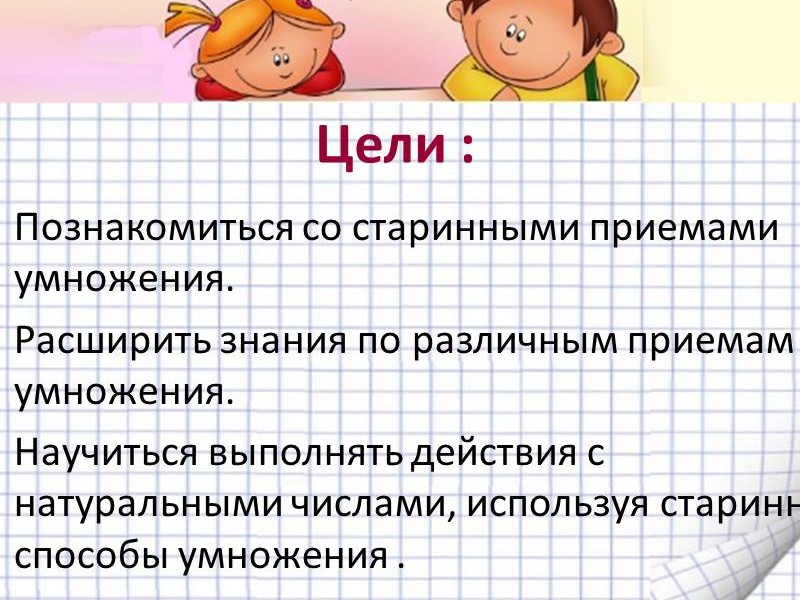


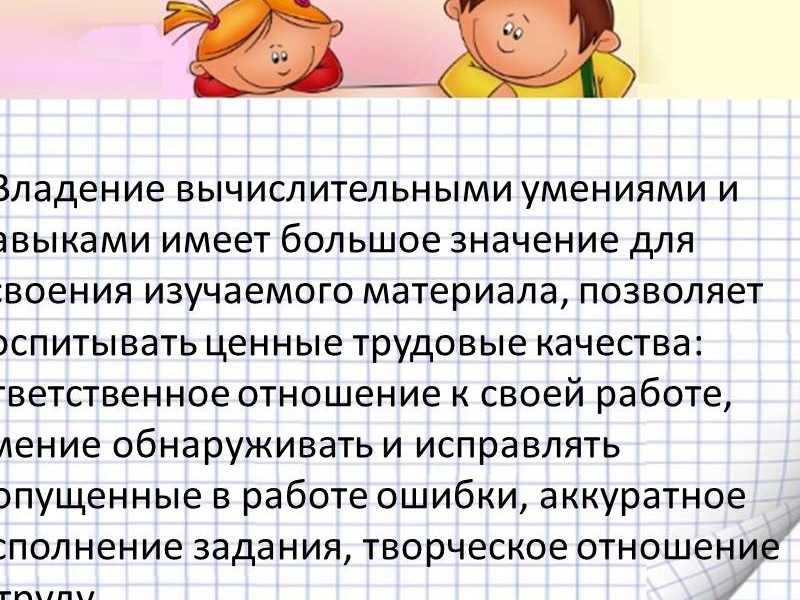

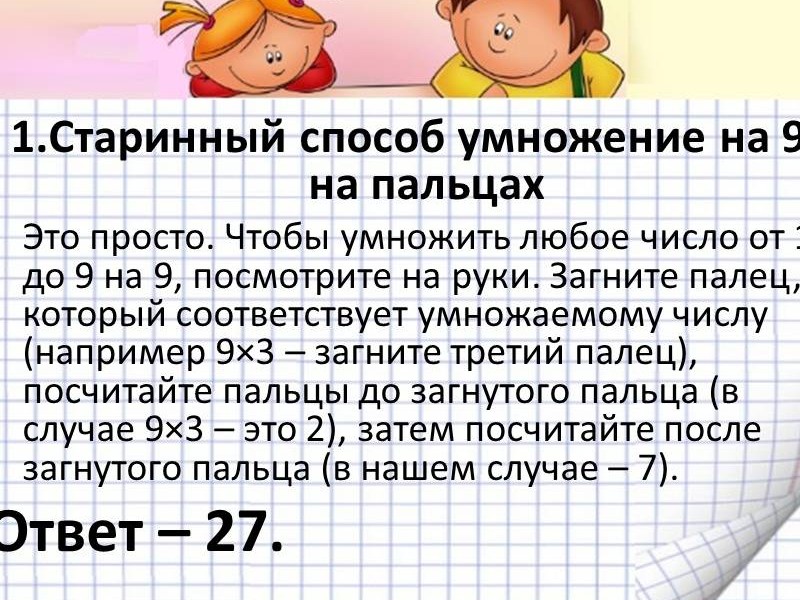
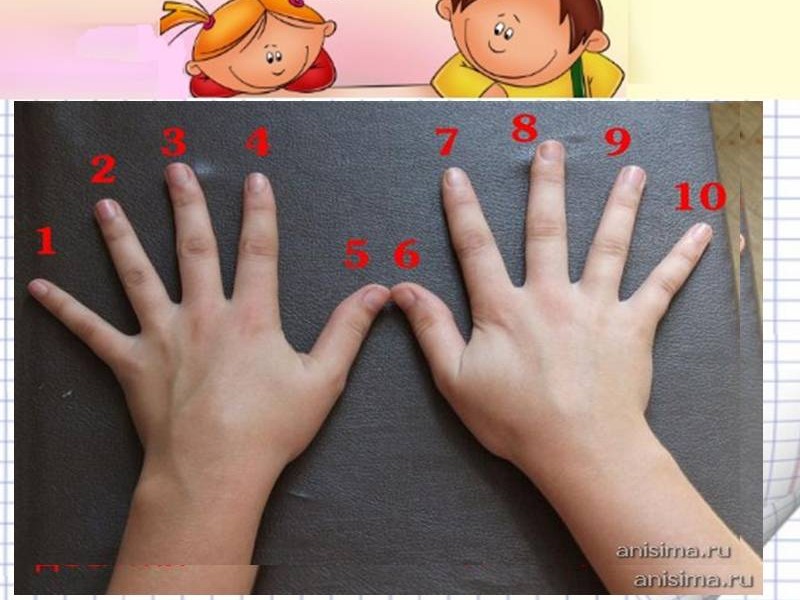
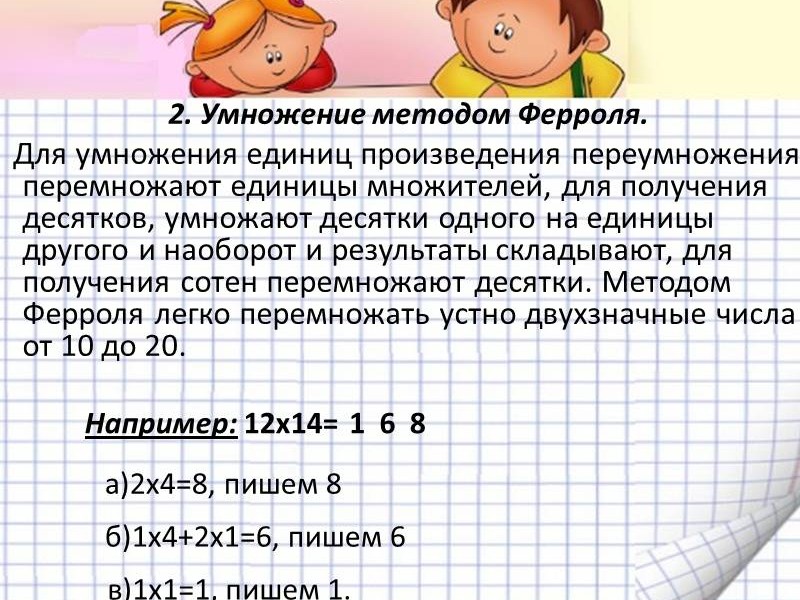
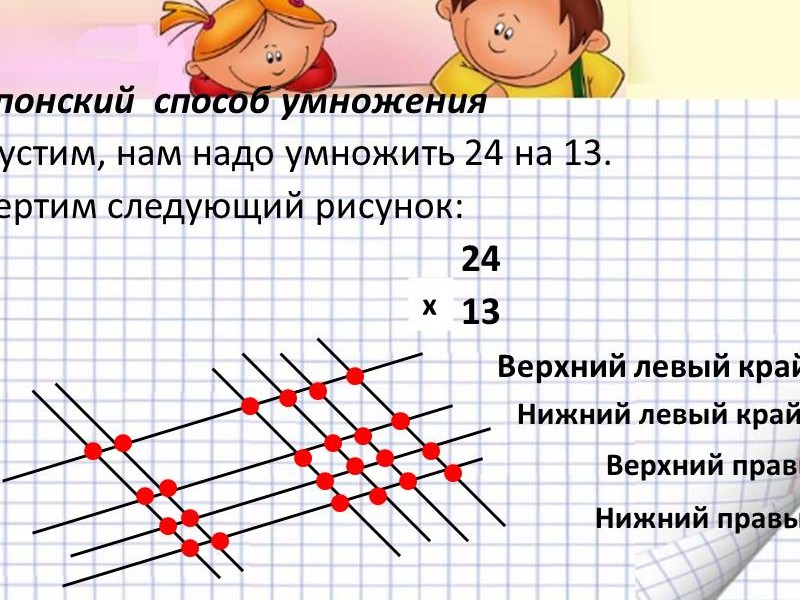
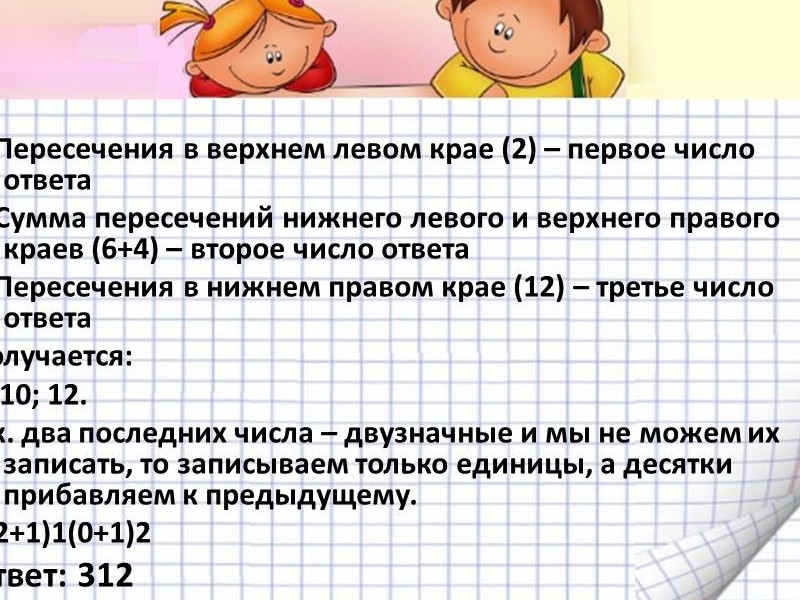
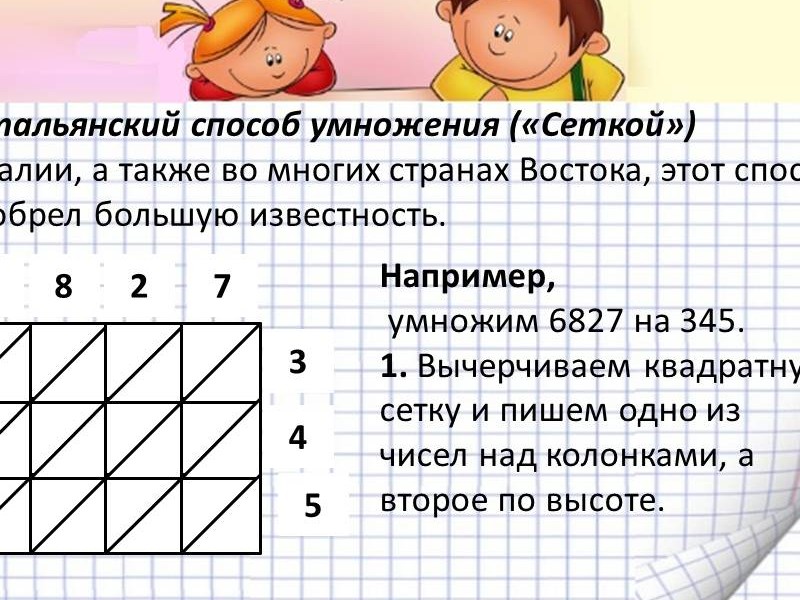
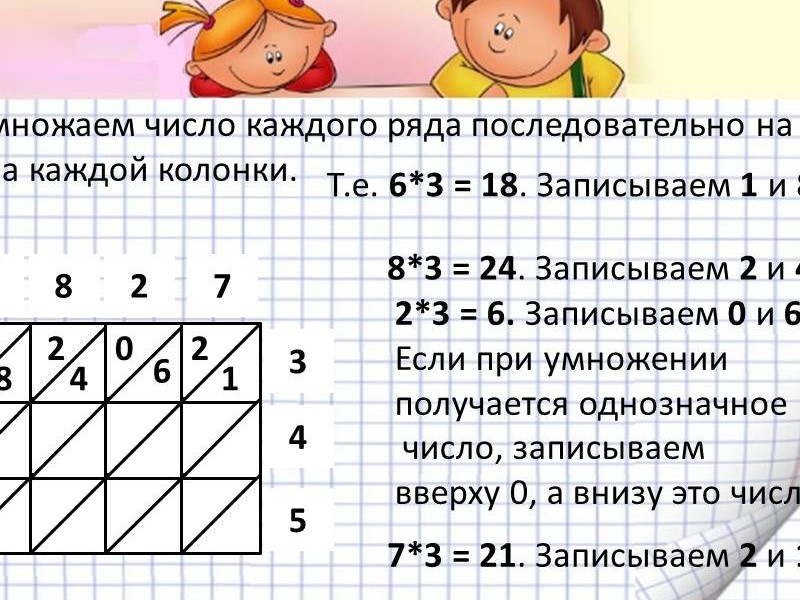
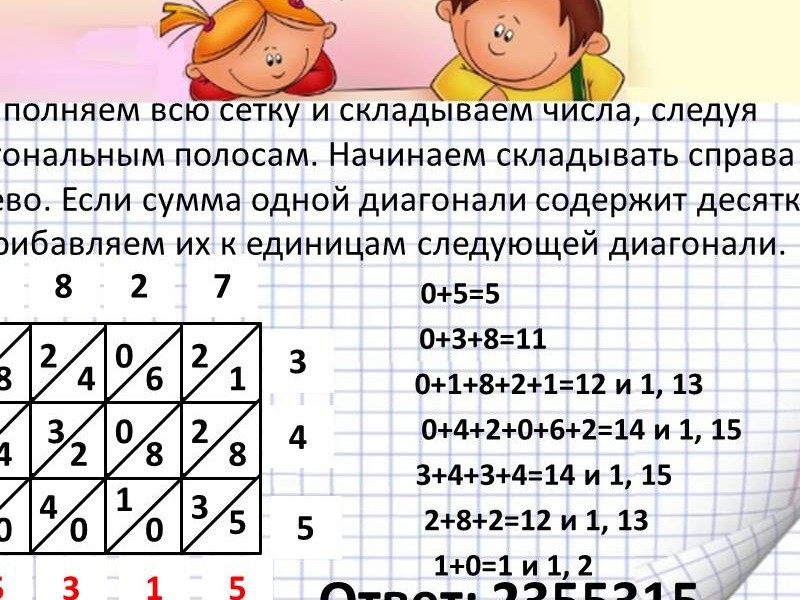

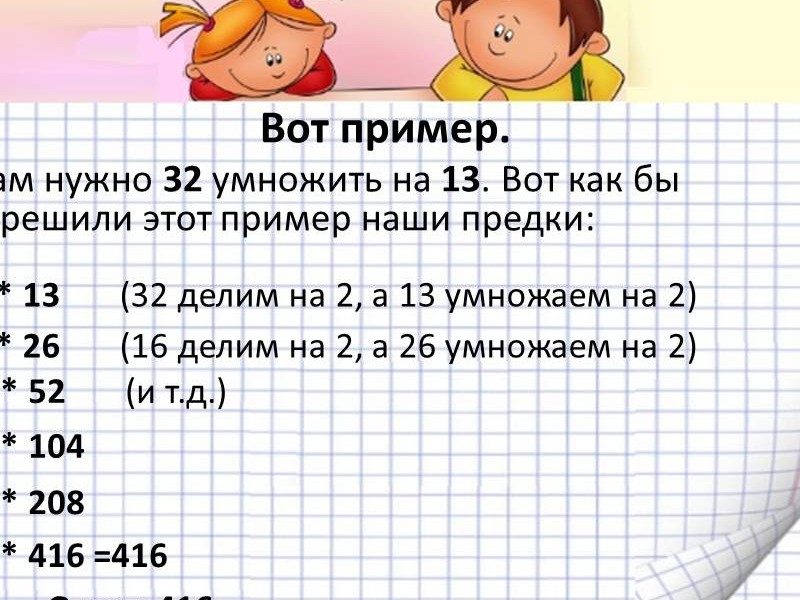
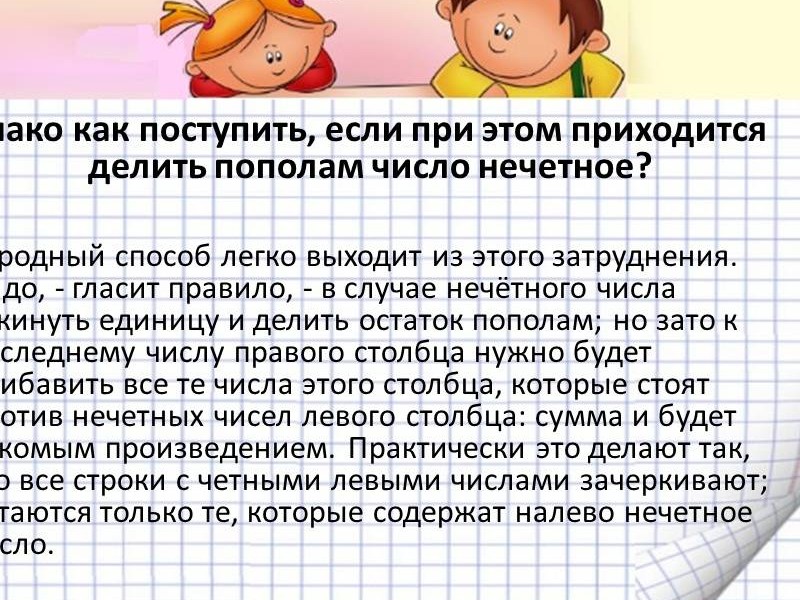
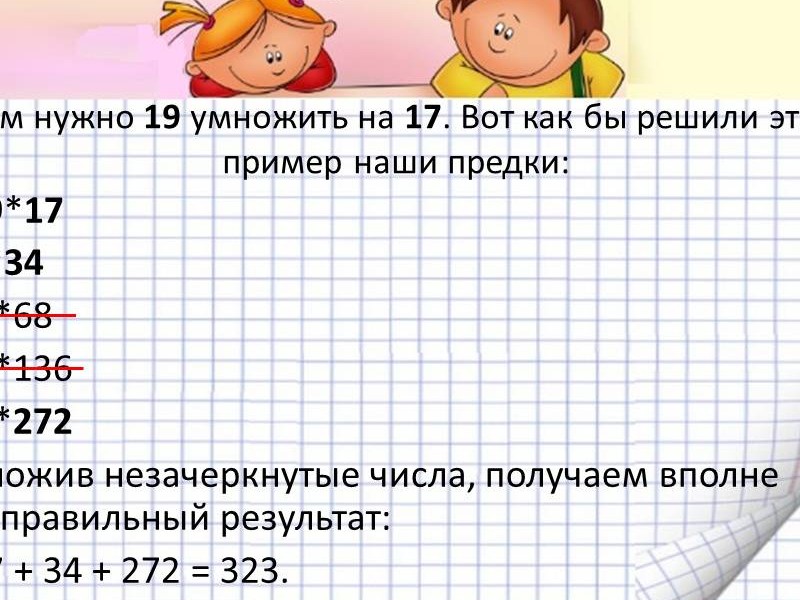
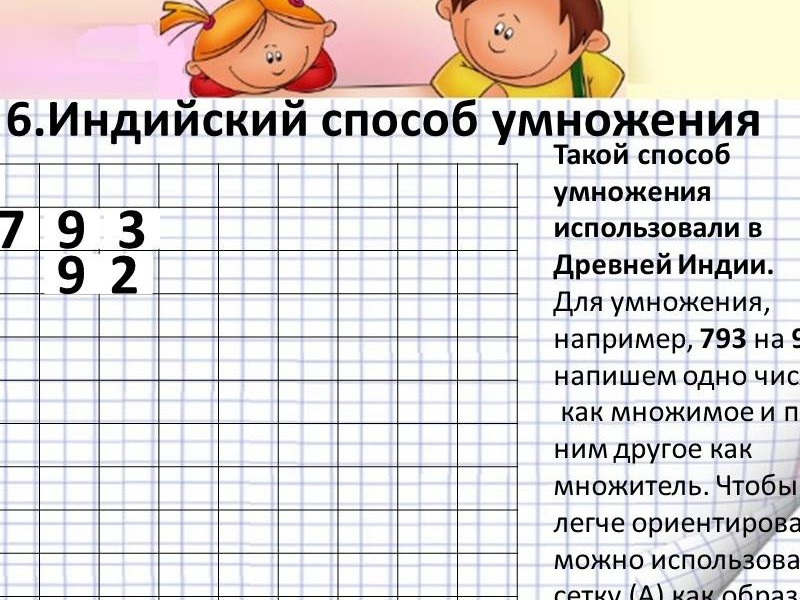
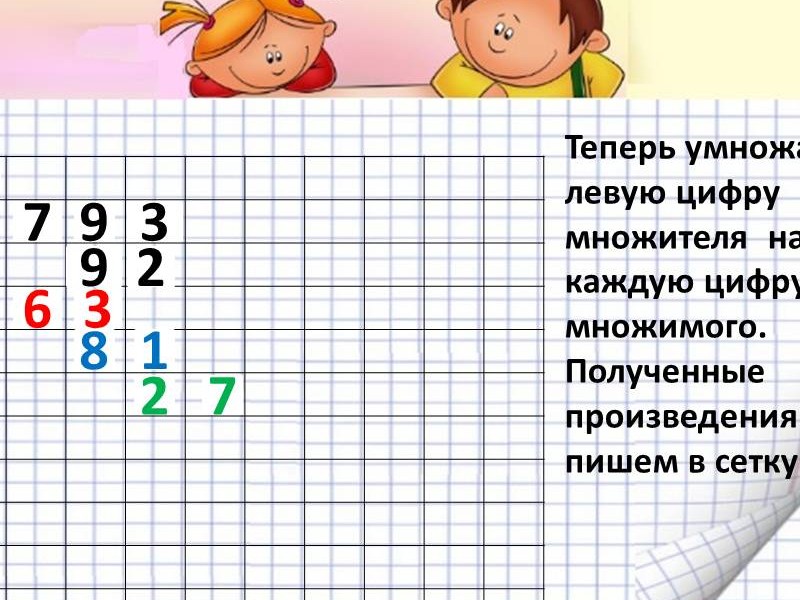
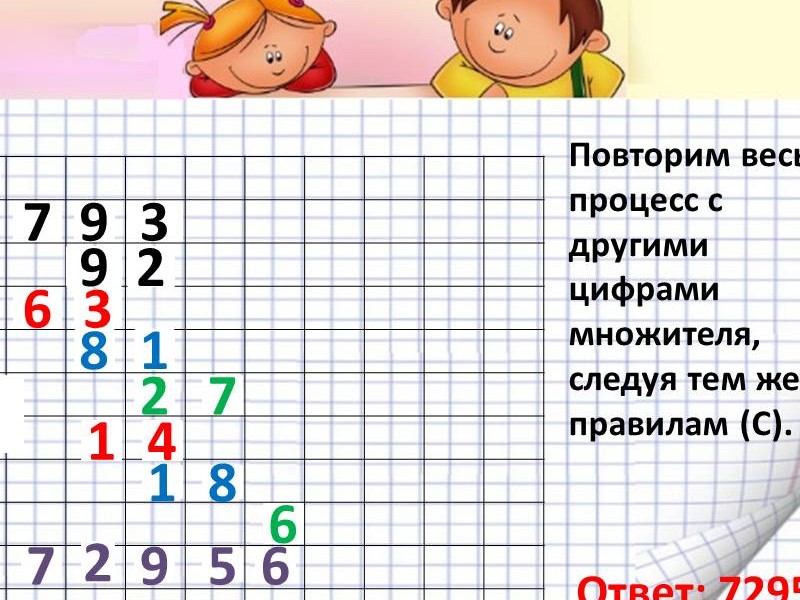
 Back Forward
Back Forward
Attention! Slide previews are for informational purposes only and may not represent all the features of the presentation. If you are interested in this work, please download the full version.
“Counting and calculations are the basis of order in the head.”
Pestalozzi
Target:
- Learn ancient multiplication techniques.
- Expand your knowledge of various multiplication techniques.
- Learn to perform operations with natural numbers using ancient methods of multiplication.
- The old way of multiplying by 9 on your fingers
- Multiplication by Ferrol method.
- Japanese way of multiplication.
- Italian way of multiplication (“Grid”)
- Russian method of multiplication.
- Indian way of multiplication.
Progress of the lesson
The relevance of using fast counting techniques.
In modern life, each person often has to perform a huge number of calculations and calculations. Therefore, the goal of my work is to show easy, fast and accurate methods of counting, which will not only help you during any calculations, but will cause considerable surprise among acquaintances and comrades, because the free performance of counting operations can largely indicate the extraordinary nature of your intellect. A fundamental element of computing culture is conscious and robust computing skills. The problem of developing a computing culture is relevant for the entire school mathematics course, starting from the primary grades, and requires not just mastering computing skills, but using them in various situations. Possession of computational skills is of great importance for mastering the material being studied and allows one to develop valuable work qualities: a responsible attitude to one’s work, the ability to detect and correct errors made in the work, careful execution of a task, a creative attitude to work. However, recently the level of computational skills and transformations of expressions has a pronounced downward trend, students make a lot of mistakes when calculating, increasingly use a calculator, and do not think rationally, which negatively affects the quality of education and the level of mathematical knowledge of students in general. One of the components of computing culture is mental counting, which is of great importance. The ability to quickly and correctly make simple calculations “in the head” is necessary for every person.
Ancient ways of multiplying numbers.
1. The old way of multiplying by 9 on your fingers
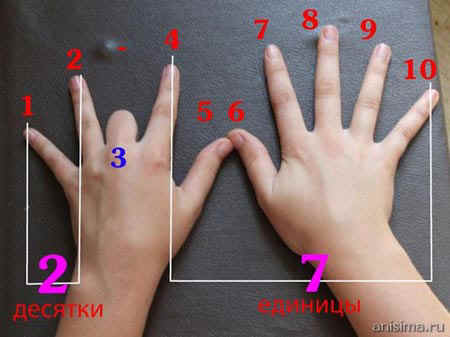
It's simple. To multiply any number from 1 to 9 by 9, look at your hands. Fold the finger that corresponds to the number being multiplied (for example, 9 x 3 - fold the third finger), count the fingers before the folded finger (in the case of 9 x 3, this is 2), then count after the folded finger (in our case, 7). The answer is 27.
2. Multiplication by the Ferrol method.
To multiply the units of the product of remultiplication, the units of the factors are multiplied; to obtain tens, the tens of one are multiplied by the units of the other and vice versa and the results are added; to obtain hundreds, the tens are multiplied. Using the Ferrol method, it is easy to multiply two-digit numbers from 10 to 20 verbally.
For example: 12x14=168
a) 2x4=8, write 8
b) 1x4+2x1=6, write 6
c) 1x1=1, write 1.
3. Japanese way of multiplication
This technique is reminiscent of multiplication by a column, but it takes quite a long time.
Using the technique. Let's say we need to multiply 13 by 24. Let's draw the following figure:
This drawing consists of 10 lines (the number can be any)
- These lines represent the number 24 (2 lines, indent, 4 lines)
- And these lines represent the number 13 (1 line, indent, 3 lines)
(intersections in the figure are indicated by dots)

Number of crossings:
- Top left edge: 2
- Bottom left edge: 6
- Top right: 4
- Bottom right: 12
1) Intersections in the upper left edge (2) – the first number of the answer
2) The sum of the intersections of the lower left and upper right edges (6+4) – the second number of the answer
3) Intersections in the lower right edge (12) – the third number of the answer.
It turns out: 2; 10; 12.
Because two last numbers- are two-digit and we cannot write them down, then we write down only ones, and add tens to the previous one.
4. Italian way of multiplication (“Grid”)
In Italy, as well as in many Eastern countries, this method has gained great popularity.
Using the technique:
For example, let's multiply 6827 by 345.
1. Draw a square grid and write one of the numbers above the columns, and the second in height.
2. Multiply the number of each row sequentially by the numbers of each column.
- 6*3 = 18. Write 1 and 8
- 8*3 = 24. Write 2 and 4
If multiplication results in a single-digit number, write 0 at the top and this number at the bottom.
(As in our example, when multiplying 2 by 3, we got 6. We wrote 0 at the top and 6 at the bottom)
3. Fill in the entire grid and add up the numbers following the diagonal stripes. We start folding from right to left. If the sum of one diagonal contains tens, then add them to the units of the next diagonal.
Answer: 2355315.
5. Russian method of multiplication.
This multiplication technique was used by Russian peasants approximately 2-4 centuries ago, and was developed in ancient times. The essence of this method is: “As much as we divide the first factor, we multiply the second by that much.” Here is an example: We need to multiply 32 by 13. This is how our ancestors would have solved this example 3-4 centuries ago:
- 32 * 13 (32 divided by 2, and 13 multiplied by 2)
- 16 * 26 (16 divided by 2, and 26 multiplied by 2)
- 8 * 52 (etc.)
- 4 * 104
- 2 * 208
- 1 * 416 =416
Dividing in half continues until the quotient reaches 1, while simultaneously doubling the other number. The last doubled number gives the desired result. It is not difficult to understand what this method is based on: the product does not change if one factor is halved and the other is doubled. It is therefore clear that as a result of repeated repetition of this operation, the desired product is obtained
However, what should you do if you have to divide an odd number in half? The folk method easily overcomes this difficulty. It is necessary, says the rule, in case of an odd number, discard one and divide the remainder in half; but then to the last number of the right column you will need to add all those numbers of this column that stand opposite the odd numbers of the left column: the sum will be the required product. In practice, this is done in such a way that all lines with even left numbers are crossed out; Only those that contain an odd number to the left remain. Here's an example (asterisks indicate that this line should be crossed out):
- 19*17
- 4 *68*
- 2 *136*
- 1 *272
Adding the uncrossed numbers, we get a completely correct result:
- 17 + 34 + 272 = 323.
Answer: 323.
6. Indian way of multiplication.
This method of multiplication was used in Ancient India.
To multiply, for example, 793 by 92, we write one number as the multiplicand and below it another as the multiplier. To make it easier to navigate, you can use the grid (A) as a reference.
Now we multiply the left digit of the multiplier by each digit of the multiplicand, that is, 9x7, 9x9 and 9x3. We write the resulting products in grid (B), keeping in mind the following rules:
- Rule 1. The units of the first product should be written in the same column as the factor, that is, in in this case under 9.
- Rule 2. Subsequent works must be written in such a way that the units are placed in the column immediately to the right of the previous work.
Let's repeat the whole process with other digits of the multiplier, following the same rules (C).
Then we add up the numbers in the columns and get the answer: 72956.
As you can see, we get a large list of works. The Indians, who had extensive practice, wrote each number not in the corresponding column, but on top, as far as possible. Then they added the numbers in the columns and got the result.
Conclusion
We have entered a new millennium! Grand discoveries and achievements of mankind. We know a lot, we can do a lot. It seems something supernatural that with the help of numbers and formulas one can calculate the flight of a spaceship, the “economic situation” in the country, the weather for “tomorrow”, and describe the sound of notes in a melody. We know the statement of the ancient Greek mathematician and philosopher who lived in the 4th century BC - Pythagoras - “Everything is a number!”
According to the philosophical view of this scientist and his followers, numbers govern not only measure and weight, but also all phenomena occurring in nature, and are the essence of harmony reigning in the world, the soul of the cosmos.
Describing ancient methods of calculation and modern methods of quick calculation, I tried to show that both in the past and in the future, one cannot do without mathematics, a science created by the human mind.
“Whoever studies mathematics from childhood develops attention, trains the brain, his will, and cultivates perseverance and perseverance in achieving goals.”(A. Markushevich)
Literature.
- Encyclopedia for children. "T.23". Universal Encyclopedic Dictionary \ ed. board: M. Aksenova, E. Zhuravleva, D. Lyury and others - M.: World of Encyclopedias Avanta +, Astrel, 2008. - 688 p.
- Ozhegov S.I. Dictionary of the Russian language: approx. 57,000 words / Ed. member - corr. ANSIR N.YU. Shvedova. – 20th ed. – M.: Education, 2000. – 1012 p.
- I want to know everything! Large illustrated encyclopedia of intelligence / Transl. from English A. Zykova, K. Malkova, O. Ozerova. – M.: Publishing House ECMO, 2006. – 440 p.
- Sheinina O.S., Solovyova G.M. Mathematics. School club classes 5-6 grades / O.S. Sheinina, G.M. Solovyov - M.: Publishing house NTsENAS, 2007. - 208 p.
- Kordemsky B. A., Akhadov A. A. Amazing world numbers: Book of students, - M. Education, 1986.
- Minskikh E. M. “From game to knowledge”, M., “Enlightenment” 1982.
- Svechnikov A. A. Numbers, figures, problems M., Education, 1977.
- http://matsievsky. newmail. ru/sys-schi/file15.htm
- http://sch69.narod. ru/mod/1/6506/hystory. html



